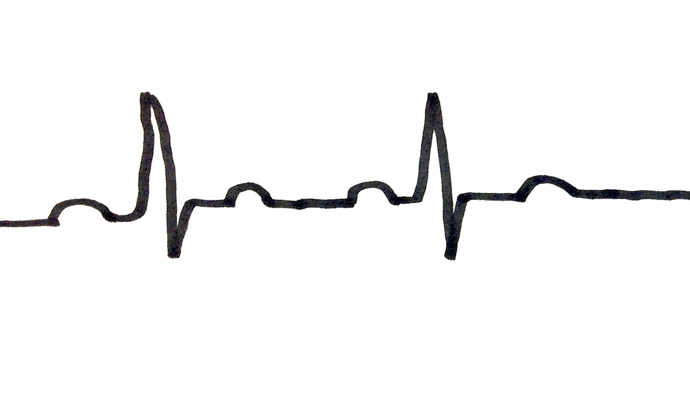Trapped between life and death
People in a vegetative state seem unresponsive, but we can now communicate with them

IMAGINE YOU WAKE UP, locked inside a box," says Adrian Owen, a neurologist at the University of Western Ontario. "It's only just big enough to hold your body but sufficiently small that you can't move. It's a perfect fit, down to every last one of your fingers and toes. It's a strange box because you can listen to absolutely everything going on around you, yet your voice cannot be heard. In fact, the box fits so tightly around your face and lips that you can't speak, or make a noise. Although you can see everything going on around the box, the world outside is oblivious to what's going on inside.
"Inside, there's plenty of time to think. At first, this feels like a game, even one that is strangely amusing. Then, reality sets in. You're trapped. You see and hear your family lamenting your fate. Over the years, the carers forget to turn on the TV. You're too cold. Then you're too hot. You're always thirsty. The visits of your friends and family dwindle. Your partner moves on. And there's nothing you can do about it."
Owen becomes animated describing the torment of those with no voice: his patients.
The Week
Escape your echo chamber. Get the facts behind the news, plus analysis from multiple perspectives.

Sign up for The Week's Free Newsletters
From our morning news briefing to a weekly Good News Newsletter, get the best of The Week delivered directly to your inbox.
From our morning news briefing to a weekly Good News Newsletter, get the best of The Week delivered directly to your inbox.
People in a "vegetative state" are awake yet unaware. Their eyes can open and sometimes wander. They can smile, grasp another's hand, cry, groan, or grunt. But they are unable to see or to understand speech. Their motions are not purposeful but reflexive. They appear to have shed their memories, emotions, and intentions, those qualities that make each one of us an individual. Their minds remain firmly shut. Still, when their eyelids flutter open, you are always left wondering if there's a glimmer of consciousness.
A decade ago, the answer would have been a bleak and emphatic no. Not any longer. Using brain scanners, Owen has found that some may be trapped inside their bodies yet able to think and feel to varying extents. The number of patients with disorders of consciousness has soared in recent decades, ironically, because of the rise and success of intensive care and medical technologies. Doctors have steadily got better at saving patients with catastrophic injuries, though it remains much easier to restart a heart than restore a brain. Today, trapped, damaged, and diminished minds inhabit clinics and nursing homes worldwide — in Europe alone the number of new coma cases is estimated to be around 230,000 annually, of which some 30,000 will languish in a persistent vegetative state. They are some of the most tragic and expensive artifacts of modern intensive care.
OWEN KNOWS THIS only too well. In 1997, a close friend set off on her usual cycle to work. She had a weak spot on a blood vessel in her head, known as a brain aneurysm. Five minutes into her trip, the aneurysm burst and she crashed into a tree. She never regained consciousness.
The tragedy left Owen numb, yet his friend's accident would shape the rest of his life. He began to wonder if there was a way to determine which of these patients were in an unconscious coma, which were conscious, and which were somewhere in between?
A free daily email with the biggest news stories of the day – and the best features from TheWeek.com
That year, he had moved to Cambridge University, where researchers used various scanning techniques. One, positron emission tomography (PET), highlights different metabolic processes in the brain, such as oxygen and sugar use. Another, known as functional magnetic resonance imaging (fMRI), can reveal active centers in the brain by detecting the tiny surges in blood flow that take place as a mind whirs. Owen wondered whether he could use these technologies to reach out to patients, like his friend, stuck between sensibility and oblivion. At the core was a deceptively simple question: How do we know that another person is conscious?
What do we mean by "dead"? And who should declare when an individual is dead? A priest? A lawyer? A doctor? A machine? Owen discussed these issues at a symposium in Brazil with the Dalai Lama and says he was surprised to find that they both agreed strongly on one point: We need to create an ethical framework for science that is based on secular, rather than religious, views; science alone should define what we mean by death.
The problem is that the scientific definition of "death" remains as unresolved as the definition of "consciousness." Much confusion is sowed by the term "clinical death," the cessation of blood circulation and breathing. Even though this is reversible, the term is often used by mind-body dualists who cling to the belief that a soul (or self) can persist separately from the body. Today, however, being alive is no longer linked to having a beating heart, explains Owen. If I have an artificial heart, am I dead? If you are on a life-support machine, are you dead? Is a failure to sustain independent life a reasonable definition of death? No, otherwise we would all be "dead" in the nine months before birth.
The issue becomes murkier when we consider those trapped in the twilight worlds between normal life and death — from those who slip in and out of awareness, who are trapped in a "minimally conscious state," to those who are severely impaired in a vegetative state or a coma. These patients first appeared in the wake of the development of the artificial respirator during the 1950s in Denmark, an invention that redefined the end of life in terms of the idea of brain death and created the specialty of intensive care.

IN 2006, OWEN was trying to find a reliable way to communicate with patients in a vegetative state, including Gillian [not her real name]. In July 2005, this 23-year-old had been crossing a road, chatting on her mobile phone. She was struck by two cars. Yet, though she had been diagnosed as vegetative, there was something about her that caught the attention of her doctor, who submitted her for study by Owen.
Five months later, a strange stroke of serendipity allowed Gillian to unlock her box. The key arose from a study Owen started with Steven Laureys in 2005. They had asked healthy volunteers to imagine doing different things, such as singing songs or conjuring up the face of their mother. Then Owen had another idea. "I just had a hunch," he says. "I asked a healthy control to imagine playing tennis. Then I asked her to imagine walking through the rooms of her house." Imagining tennis activates part of the cortex, called the supplementary motor area, involved in the mental simulation of movements. But imagining walking around the house activates the parahippocampal gyrus in the core of the brain, the posterior parietal lobe, and the lateral premotor cortex. The two patterns of activity were as distinct as a "yes" and a "no." So, if people were asked to imagine tennis for "yes" and walking around the house for "no," they could answer questions via fMRI.
Gazing into Gillian's "vegetative" brain with the brain scanner, Owen asked her to imagine the same things — and saw strikingly similar activation patterns to the healthy volunteers. It was an electric moment. Owen could read her mind.
Gillian's case, published in the journal Science in 2006, made front-page headlines around the world. The result provoked wonder and, of course, disbelief. "Broadly speaking, I received two types of email from my peers," says Owen. "They either said, 'This is amazing — well done!' or, 'How could you possibly say this woman is conscious?'"
As the old saw goes, extraordinary claims require extraordinary evidence. The skeptics countered that it was wrong to make these "radical inferences" when there could be a more straightforward interpretation. Daniel Greenberg, a psychologist at the University of California, Los Angeles, suggested that "the brain activity was unconsciously triggered by the last word of the instructions, which always referred to the item to be imagined."
Since Owen's 2006 Science paper, studies in Belgium, the U.K., the U.S., and Canada suggest that a significant proportion of patients who were classified as vegetative in recent years have been misdiagnosed — Owen estimates perhaps as many as 20 percent. Nicholas Schiff, a neurologist who weighs up the extent of misdiagnosis a different way, goes further. Based on recent studies, he says around 40 percent of patients thought to be vegetative are, when examined more closely, partly aware.
In 2009, Laureys's team asked one of the original group of 54 patients that he and Owen had studied — patient 23 — a series of yes-or-no questions. It was the usual drill: Imagine playing tennis for yes, navigating the house for no. The patient, who had been in a vegetative state for five years, was able to answer five of six questions about his earlier life — and all of those were correct. Had he been on holiday to a certain place prior to his injury? Was such-and-such his father's name? It was an exciting moment, said Laureys. "We were stunned," adds Owen, who helped independently score the tests. "By showing us that he was conscious and aware, patient 23 moved himself from the 'do not resuscitate' category to the 'not allowed to die' category. Did we save his life? No. He saved his own life."
THIS IS YOUR big chance. Just do your best." Owen gazed down at 39-year-old Scott Routley, lying on a gurney. Scott had studied physics at the University of Waterloo, Ontario, but his promising career in robotics came to an end when, aged 26, he collided with a police vehicle. Since that accident, in 1999, Scott had been diagnosed as being in a vegetative state by a well-seasoned neurologist, Bryan Young, and in 2012 his diagnosis was confirmed by Owen's team, again using traditional methods.
As Owen talked to him, Scott's mouth remained wide open, the same way that he'd been in the 12 years since the accident. This encounter was filmed by a crew from the BBC. A reporter was there to witness the moment that Owen attempted to reach inside Scott's mind. Owen admits now that he was skeptical that the scans would reveal anything at all.
The team scanned Scott several times. To their surprise, the pattern of brain activity showed that Scott knew exactly who he was, where he was, and that he was actively choosing to answer the team's questions. "My heart stopped when we asked if, after 12 years, Scott was in pain," Owen recalls. "Thankfully, the answer was no."
The BBC crew was surprised at the family's relative lack of celebration. Not Owen. Scott's family had always been convinced that he was conscious. Perhaps the family discerned subtle signs of consciousness that were almost undetectable, even to the trained eye. Or perhaps they had deceived themselves, as many families do for comfort. "Either way, it was the word of the family against that of my team, and their word against an army of specialists over many years," says Owen. Where the family saw a sign of cognition, the doctors saw only wishful thinking. "The scans showed that they were right, perhaps for the wrong reasons — we will never know — but Scott's story teaches us the value of objective measures. And the need for a little humility."
Adapted from a longer article that originally appeared at MosaicScience.com. CC BY The Wellcome Trust.
-
 Could smaller cars bring down vehicle prices?
Could smaller cars bring down vehicle prices?Today’s Big Question Trump seems to think so, but experts aren’t so sure
-
 2025’s most notable new albums
2025’s most notable new albumsThe Week Recommends These were some of the finest releases of the past year
-
 Trump aims to take down ‘global mothership’ of climate science
Trump aims to take down ‘global mothership’ of climate scienceIN THE SPOTLIGHT By moving to dismantle Colorado’s National Center for Atmospheric Research, the White House says it is targeting ‘climate alarmism’